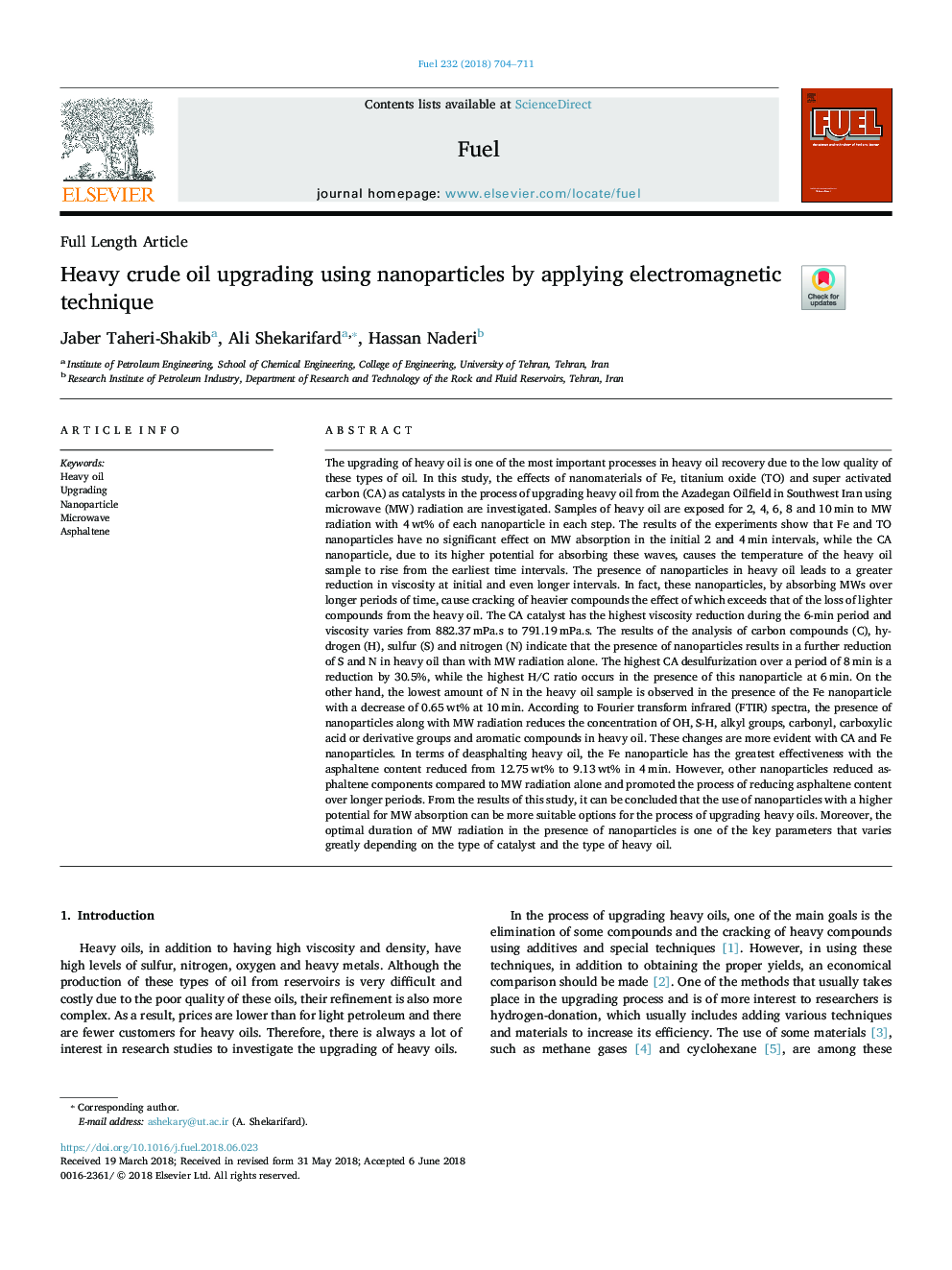| کد مقاله | کد نشریه | سال انتشار | مقاله انگلیسی | نسخه تمام متن |
|---|---|---|---|---|
| 6630474 | 1424932 | 2018 | 8 صفحه PDF | دانلود رایگان |
عنوان انگلیسی مقاله ISI
Heavy crude oil upgrading using nanoparticles by applying electromagnetic technique
ترجمه فارسی عنوان
با استفاده از تکنیک الکترومغناطیسی، استفاده از نانو ذرات سنگین را با استفاده از نانوذرات بهبود می بخشد
دانلود مقاله + سفارش ترجمه
دانلود مقاله ISI انگلیسی
رایگان برای ایرانیان
کلمات کلیدی
روغن سنگین، ارتقاء، نانوذرات، مایکروویو، آسفالتین،
موضوعات مرتبط
مهندسی و علوم پایه
مهندسی شیمی
مهندسی شیمی (عمومی)
چکیده انگلیسی
The upgrading of heavy oil is one of the most important processes in heavy oil recovery due to the low quality of these types of oil. In this study, the effects of nanomaterials of Fe, titanium oxide (TO) and super activated carbon (CA) as catalysts in the process of upgrading heavy oil from the Azadegan Oilfield in Southwest Iran using microwave (MW) radiation are investigated. Samples of heavy oil are exposed for 2, 4, 6, 8 and 10â¯min to MW radiation with 4â¯wt% of each nanoparticle in each step. The results of the experiments show that Fe and TO nanoparticles have no significant effect on MW absorption in the initial 2 and 4â¯min intervals, while the CA nanoparticle, due to its higher potential for absorbing these waves, causes the temperature of the heavy oil sample to rise from the earliest time intervals. The presence of nanoparticles in heavy oil leads to a greater reduction in viscosity at initial and even longer intervals. In fact, these nanoparticles, by absorbing MWs over longer periods of time, cause cracking of heavier compounds the effect of which exceeds that of the loss of lighter compounds from the heavy oil. The CA catalyst has the highest viscosity reduction during the 6-min period and viscosity varies from 882.37â¯mPa.s to 791.19â¯mPa.s. The results of the analysis of carbon compounds (C), hydrogen (H), sulfur (S) and nitrogen (N) indicate that the presence of nanoparticles results in a further reduction of S and N in heavy oil than with MW radiation alone. The highest CA desulfurization over a period of 8â¯min is a reduction by 30.5%, while the highest H/C ratio occurs in the presence of this nanoparticle at 6â¯min. On the other hand, the lowest amount of N in the heavy oil sample is observed in the presence of the Fe nanoparticle with a decrease of 0.65â¯wt% at 10â¯min. According to Fourier transform infrared (FTIR) spectra, the presence of nanoparticles along with MW radiation reduces the concentration of OH, S-H, alkyl groups, carbonyl, carboxylic acid or derivative groups and aromatic compounds in heavy oil. These changes are more evident with CA and Fe nanoparticles. In terms of deasphalting heavy oil, the Fe nanoparticle has the greatest effectiveness with the asphaltene content reduced from 12.75â¯wt% to 9.13â¯wt% in 4â¯min. However, other nanoparticles reduced asphaltene components compared to MW radiation alone and promoted the process of reducing asphaltene content over longer periods. From the results of this study, it can be concluded that the use of nanoparticles with a higher potential for MW absorption can be more suitable options for the process of upgrading heavy oils. Moreover, the optimal duration of MW radiation in the presence of nanoparticles is one of the key parameters that varies greatly depending on the type of catalyst and the type of heavy oil.
ناشر
Database: Elsevier - ScienceDirect (ساینس دایرکت)
Journal: Fuel - Volume 232, 15 November 2018, Pages 704-711
Journal: Fuel - Volume 232, 15 November 2018, Pages 704-711
نویسندگان
Jaber Taheri-Shakib, Ali Shekarifard, Hassan Naderi,
